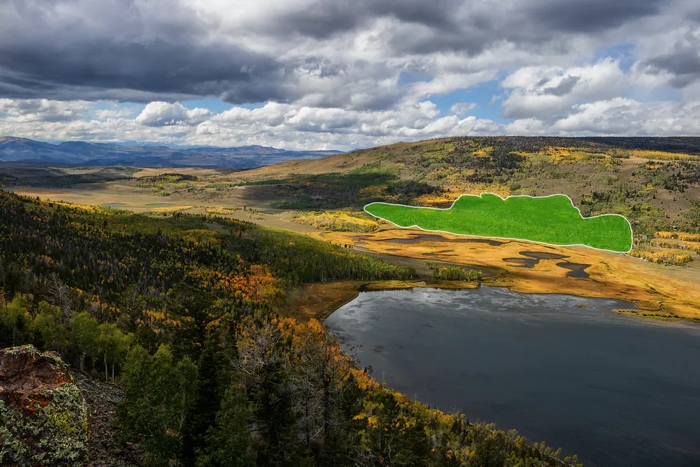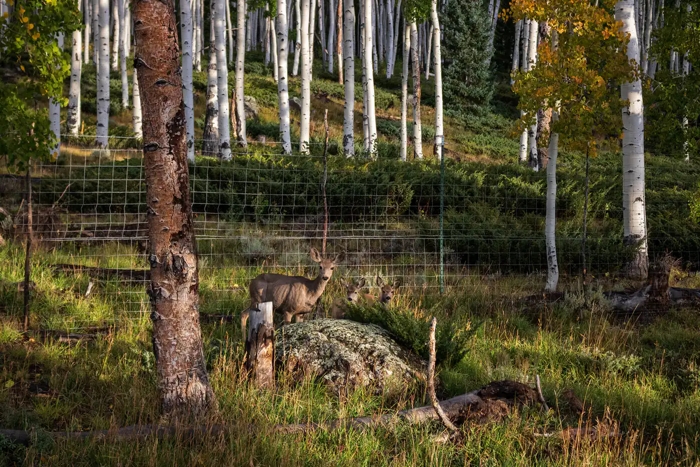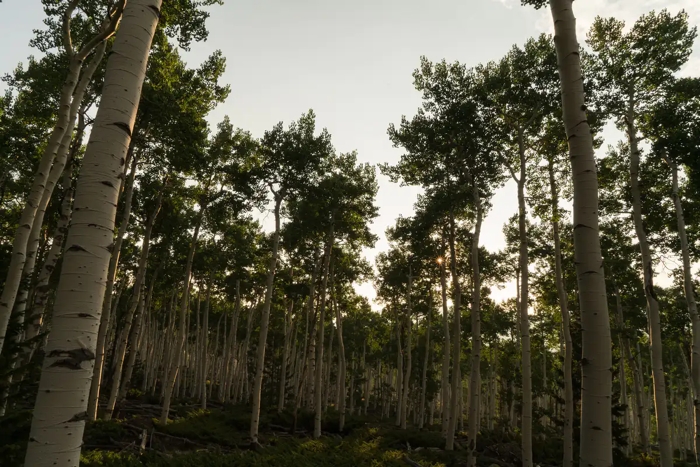In the Wasatch Mountains in the western US on the slopes above a fed lake, there is a large ecosystem that provides an ecosystem that plants and animals have depended on for thousands of years. .
Found in my home state of Utah, “Pando” is a 106 acre site of vibrant aspen clones.
Although it looks like a forest where every tree has white bark and small leaves fluttering in the breeze, Pando (Latin for “I spread”) is actually 47,000 genes from the network connected by roots.
This genetic group is about 6,000 metric tons. By mass, it is one of the largest in the world.
 Pando’s panoramic views, with a pool in front. (Lance Oditt/Friends of Pando)
Pando’s panoramic views, with a pool in front. (Lance Oditt/Friends of Pando)
Aspen trees grow in other places, but what makes Pando so interesting is its size. Most clonal aspen stands in North America are small, while those in the western US cover only 3 acres.
Pando has been around for thousands of years, possibly up to 14,000 years, although most will only live for around 130 years. Its longevity and remoteness means an ecosystem of 68 species of plants and many animals has evolved and support him under his shadow.
All of this ecosystem is based on healthy and stable aspen. But, although Pando is protected by the US National Forest Service and is not in danger of being cut down, it is in danger of disappearing due to many other reasons.
Deer eats the least amount of ‘wood’.
Grazing of deer and elk is one of the biggest concerns. Wolves and cougars once maintained their numbers, but herds are now large due to the loss of these animals.
Deer and elk also congregate in Pando as the protection afforded by the forest means they are not at risk of being hunted there.
 Deer eating Pando Ome. (Lance Oditt/Friends of Pando)
Deer eating Pando Ome. (Lance Oditt/Friends of Pando)
As the older trees die or fall, fire reaches the forest floor which stimulates new clonal trees to start growing, but when these animals eat the surface and – this new shape you will, they are dying. This means that a large part of Pando has little new growth.
The exception is one area that was fenced off a few years ago to remove dying trees. This enclosed area has eliminated elk and deer and has seen the successful establishment of new clonal vegetation, with high growth called “bamboo plantations”.
Disease and climate change
At least three diseases affect old trees in Pando: sooty bark disease, leaf spot, and fungal conk disease.
Although the plant disease has developed and thrives in the aspen representing tens of thousands of years, it is not known what the long-term effects on the environment may be, since there is no new progress and the list is increasing the surface of other pressures and clonal giant. .
The fastest growing threat is climate change. Pando arose after the last ice age and has dealt with a stable climate ever since.
 Pando survived disease, hunting, and colonization. (Lance Oditt/Friends of Pando)
Pando survived disease, hunting, and colonization. (Lance Oditt/Friends of Pando)
In fact, it lives in an alpine region surrounded by desert, which means that it is not unusual for hot temperatures or droughts. But climate change threatens the extent and longevity of the plant, as well as the ecosystem it supports.
Although no scientific studies have focused specifically on Pando, aspen stands have been struggling with climate change pressures, such as reduced water supply and warmer weather earlier in the year, and -makes it difficult for the plant to produce new leaves, which causes it to fall. and insurance.
With competition for ever-decreasing water resources (nearby Fish Lake has yet to reach the plant’s root system), temperatures are expected to continue rising to record highs in summer, and the threat of fire is getting stronger, Pando will work harder. adapt to these changing conditions quickly while maintaining its size.
The next 14,000 years
Yet Pando is flexible and has survived rapid environmental changes, especially when European settlers began to settle in the area in the 19th century or after the rise of recreational activities in the 19th century. 20. He has cured disease, forest fires, and grazing before remaining the largest scientifically recorded living creature in the world.
Regardless of the cause of concern, there is hope as scientists help us uncover the secrets of Pando’s resilience, while conservation groups and the US Forest Service work to protect this tree and his environment. A group called Friends of Pando aims to make the plant accessible to almost everyone through 360 video.
One summer, while visiting my family in Utah, I took the opportunity to visit Pando. I spent two amazing days walking under mature trees swaying and shivering in the gentle breeze, among the new growth in the “bamboo garden”, and even in the grass a knife that hits the part of the frame that is closed.
I marveled at the wildflowers and other plants that grew under the canopy, and I had the pleasure of seeing insects, birds, foxes, beavers, and deer, which used some parts of the forest. of the ecosystem created by Pando.
It is these times that remind us that we have plants, animals, and ecosystems that need to be protected. In Pando, we get a rare opportunity to protect all three.![]()
Richard Elton Walton, Postdoctoral Research Associate in Biology, Newcastle University.
This article is reprinted from The Conversation under a Creative Commons license. Read the first article.
The first edition of this article was published in November 2021.
#worlds #largest #creatures #eaten #slowly #scientist